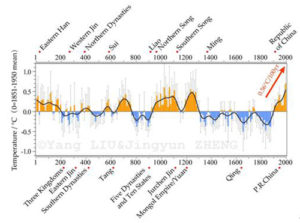by Vanderbilt University, from WUWT, June 20, 2017
Wet and stormy weather lashed California coast… 8,200 years ago
First high resolution evidence of California climate response to Holocene 8.2 ka event
The weather report for California 8,200 years ago was exceptionally wet and stormy.
That is the conclusion of a paleoclimate study that analyzed stalagmite records from White Moon Cave in the Santa Cruz Mountains published online Jun. 20 in Scientific Reports.
The Golden State’s 150-year stretch of unusually wet weather appears to have been marked by particularly intense winter storms and coincides with a climate anomaly in Greenland ice cores first detected in 1997. Before this “8.2 ka event” was discovered scientists thought the world’s climate had been unusually stable during the Holocene, the geological epoch that covers the last 11,700 years of Earth’s history.



